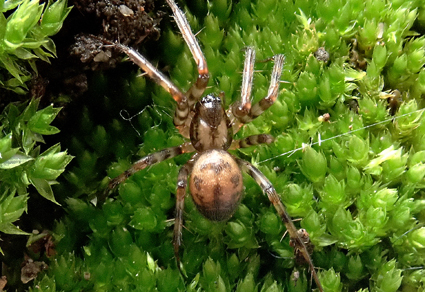Abstract
Two new species of the genus Putaoa Hormiga and Tu, 2008 from southern China are described, Putaoa annulata n. sp. (♂♀) and Putaoa titanoverpa n. sp. (♂♀), for a total number of five described species in this genus. Detailed descriptions and illustrations of the two new species are provided. A map of collecting localities is also provided for all five Putaoa species.
References
- Arnedo, M.A. & Hormiga, G. (2021) Repeated colonization, adaptive radiation and convergent evolution in the sheet-weaving spiders (Linyphiidae) of the south Pacific Archipelago of Juan Fernandez. Cladistics, 37, 317–342. https://doi.org/10.1111/cla.12437
- Álvarez-Padilla, F. & Hormiga, G. (2007) A protocol for digesting internal soft tissues and mounting spiders for scanning electron microscopy. The Journal of Arachnology, 35 (3), 538–542. https://doi.org/10.1636/Sh06-55.1
- Frick, H. & Scharff, N. (2014). Phantoms of Gondwana?—phylogeny of the spider subfamily Mynogleninae (Araneae: Linyphiidae). Cladistics, 30 (1), 67–106.
- https://doi.org/10.1111/cla.12025
- Helsdingen, P. J. van (1969) A reclassification of the species of Linyphia Latreille based on the functioning of the genitalia (Araneida, Linyphiidae), I. Zoologische Verhandelingen, 105, 1–303.
- Hormiga, G. (1994) Cladistics and the comparative morphology of linyphiid spiders and their relatives (Araneae, Araneoidea, Linyphiidae), Zoological Journal of the Linnean Society, 111 (1), 1–71. https://doi.org/10.1111/j.1096-3642.1994.tb01491.x
- Hormiga, G., Arnedo, M.A. & Gillespie, R.G. (2003) Speciation on a Conveyor Belt: Sequential Colonization of the Hawaiian Islands by Orsonwelles Spiders (Araneae, Linyphiidae). Systematic Biology, 52 (1), 70–88, https://doi.org/10.1080/10635150390132786
- Hormiga, G. & Tu, L. (2008) On Putaoa, a new genus of the spider family Pimoidae (Araneae) from China, with a cladistic test of its monophyly and phylogenetic placement. Zootaxa, 1792 (1), 1–21. https://doi.org/10.11646/zootaxa.1792.1.1
- Hormiga, G. (2008) On the spider genus Weintrauboa (Araneae, Pimoidae), with a description of a new species from China and comments on its phylogenetic relationships. Zootaxa, 1814 (1), 1–20. https://doi.org/10.11646/zootaxa.1814.1.1
- Hormiga, G. & Dimitrov, D. (2017) The discovery of the spider genus Putaoa (Araneae, Pimoidae) in Taiwan with the description of a new species, including its web architecture. Zootaxa, 4341 (1), 97–104. https://doi.org/10.11646/zootaxa.4341.1.8
- Hormiga, G., Kulkarni, S., Moreira, da Silva, T. & Dimitrov, D. (2021) Molecular phylogeny of pimoid spiders and the limits of Linyphiidae, with a reassessment of male palpal homologies (Araneae, Pimoidae). Zootaxa, 5026 (1), 71–101. https://doi.org/10.11646/zootaxa.5026.1.3
- Irfan, M. (2019) The survey of Linyphiidae spiders from South China. PhD Thesis. Hunan Normal University, Changsha, Hunan, 1094 pp.
- Janetos, A.C. (1983) Comparative ecology of two linyphiid spiders (Araneae, Linyphiidae). Journal of Arachnology, 1983, 315–322.
- Kolenda, K., Wiśniewski, K., Kujawa, K., Kuśmierek, N., Smolis, A. & Kadej, M. (2021) Living in discarded containers: spiders explore a new niche created by littering in urban woodlands. Biodiversity and Conservation, 30 (6), 1637–1654. https://doi.org/10.1007/s10531-021-02160-4
- Mammola, S., Arnedo, M.A., Pantini, P., Piano, E., Chiappetta, N. & Isaia, M. (2018) Ecological speciation in darkness? Spatial niche partitioning in sibling subterranean spiders (Araneae: Linyphiidae: Troglohyphantes). Invertebrate Systematics, 32, 1069–1082. https://doi.org/10.1071/IS17090
- Millidge, A.F. (1977) The conformation of the male palpal organs of linyphiid spiders, and its application to the taxonomic and phylogenetic analysis of the family (Araneae: Linyphiidae). Bulletin of the British Arachnological Society, 4, 1–60.
- Saaristo, M.I. (1973) Taxonomical analysis of the type-species of Agyneta, Anomalaria, Meioneta, Aprolagus, and Syedrula (Araneae, Linyphiidae). Annales Zoologici Fennici, 10, 451–466.
- Schmidt, M.H. & Tscharntke, T. (2005) Landscape context of sheetweb spider (Araneae: Linyphiidae) abundance in cereal fields. Journal of Biogeography, 32, 467–473. https://doi.org/10.1111/j.1365-2699.2004.01244.x
- Wang, F., Ballesteros, J.A., Hormiga, G., Chesters, D., Zhang, Y.J., Sun, N., Zhu, C.D., Chen, W. & Tu, L.H. (2015) Resolving the phylogeny of a speciose spider group, the family Linyphiidae (Araneae). Molecular Phylogenetics and Evolution, 91, 135–149 & Appendices. https://doi.org/10.1016/j.ympev.2015.05.005
- World Spider Catalog (2023) World Spider Catalog. Version 24. Natural History Museum Bern, Bern. Available from: http://wsc.nmbe.ch (accessed 5 April 2023) https://doi.org/10.24436/2


